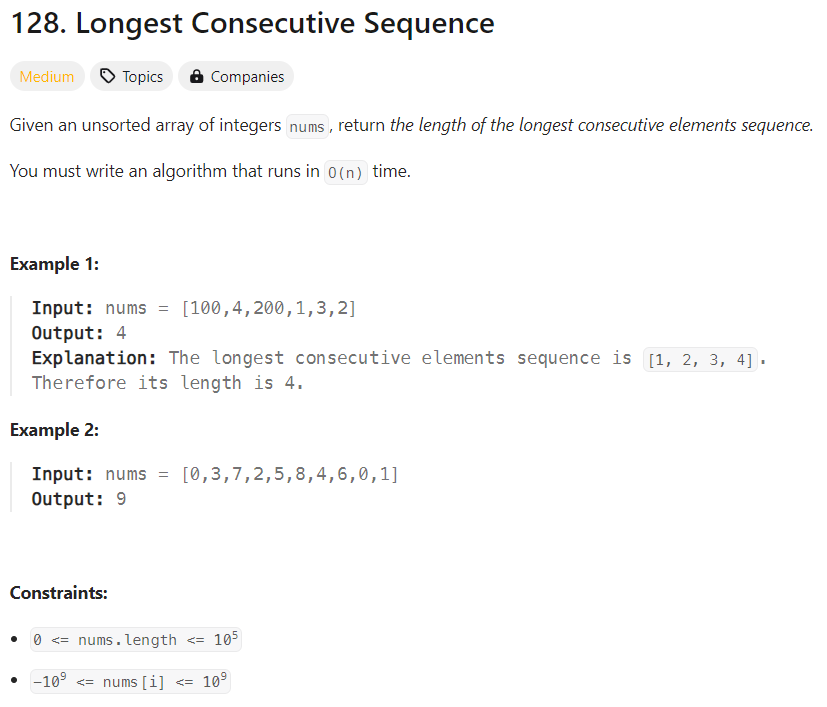一直以來,Leetcode 都被認為是最受軟體工程師歡迎的程式語言撰寫練習平台之一,其中,有幾個讓該平台廣受喜愛的原因:海量考古題、支援多種程式語言、直覺介面、解題社群與企業題庫服務。因此在這鐵人賽中,我有了想嘗試 LeetCode 考題的想法,我將利用 30 天的自主學習時間,從 FB 工程師挑選的經典題目中進行練習與理解。我也會將自學過程分享給大家,希望也能對各位有所幫助。

給定一個未排序的整數數組,返回最長的連續元素序列的長度。我們必須設計一個時間複雜度為 O(n) 的算法來解決這個問題。
如題目: [100,4,200,1,3,2] 。找到最長的連續序列為 [1,2,3,4] ,因此正確輸出為 4 。
為了在 O(n) 時間複雜度內解決這個問題,我們可以使用哈希集合(unordered_set)來高效地檢查數字的存在性。具體的解題步驟如下:
1. 使用哈希集合:我們首先將所有數字存儲到一個哈希集合中,這樣可以實現 O(1) 時間複雜度的查找操作。
2. 遍歷集合中的每個數字:對於每個數字,我們檢查它是否為某個連續序列的起點。如果 num - 1 不在集合中,那麼 num 是一個潛在的序列起點。
3. 擴展序列:從這個序列的起點開始,檢查 num + 1, num + 2, num + 3 等數字是否存在於集合中,並計算序列的長度。
4. 更新最長序列長度:在遍歷所有數字後,記錄下最長的連續序列長度。
哈希集合(Hash Set)是一種基於哈希表的數據結構,用於高效地存儲和查找唯一元素。它的主要特點包括:
1. 快速查找:平均查找、插入和刪除操作的時間複雜度為 O(1)。
2. 無序性:集合中的元素無特定順序。
3. 唯一性:不允許重複元素。
解題過程如下圖:
class Solution {
public:
int longestConsecutive(vector<int>& nums) {
if (nums.empty()) {
return 0;
}
unordered_set<int> numSet(nums.begin(), nums.end());
int longestStreak = 0;
for (int num : numSet) {
// 如果 num - 1 不在 set 中,說明這是序列的起點
if (numSet.find(num - 1) == numSet.end()) {
int currentNum = num;
int currentStreak = 1;
// 找到 num+1, num+2, num+3... 連續的數字
while (numSet.find(currentNum + 1) != numSet.end()) {
currentNum++;
currentStreak++;
}
// 更新最長的連續序列長度
longestStreak = max(longestStreak, currentStreak);
}
}
return longestStreak;
}
};
最後加入主要最後加入程式的進入點來實現整體操作:
int Main() {
string input;
getline(cin, input); // 讀取整行輸入
// 移除方括號
input = input.substr(1, input.size() - 2);
vector<int> nums;
stringstream ss(input);
string temp;
// 使用逗號分隔數字並存入 vector
while (getline(ss, temp, ',')) {
nums.push_back(stoi(temp)); // 將字串轉換為整數並存入 nums
}
// 創建 Solution 類別的實例並調用 longestConsecutive 函數
Solution sol;
int result = sol.longestConsecutive(nums);
cout << result << endl;
return 0;
}
完整程式碼:
#include <iostream>
#include <sstream>
#include <unordered_set>
#include <vector>
using namespace std;
class Solution {
public:
int longestConsecutive(vector<int>& nums) {
if (nums.empty()) {
return 0;
}
unordered_set<int> numSet(nums.begin(), nums.end());
int longestStreak = 0;
for (int num : numSet) {
// 如果 num - 1 不在 set 中,說明這是序列的起點
if (numSet.find(num - 1) == numSet.end()) {
int currentNum = num;
int currentStreak = 1;
// 找到 num+1, num+2, num+3... 連續的數字
while (numSet.find(currentNum + 1) != numSet.end()) {
currentNum++;
currentStreak++;
}
// 更新最長的連續序列長度
longestStreak = max(longestStreak, currentStreak);
}
}
return longestStreak;
}
};
int Main() {
string input;
getline(cin, input); // 讀取整行輸入
// 移除方括號
input = input.substr(1, input.size() - 2);
vector<int> nums;
stringstream ss(input);
string temp;
// 使用逗號分隔數字並存入 vector
while (getline(ss, temp, ',')) {
nums.push_back(stoi(temp)); // 將字串轉換為整數並存入 nums
}
// 創建 Solution 類別的實例並調用 longestConsecutive 函數
Solution sol;
int result = sol.longestConsecutive(nums);
cout << result << endl;
return 0;
}
以上是第一天的自學內容分享,謝謝大家。![]()
